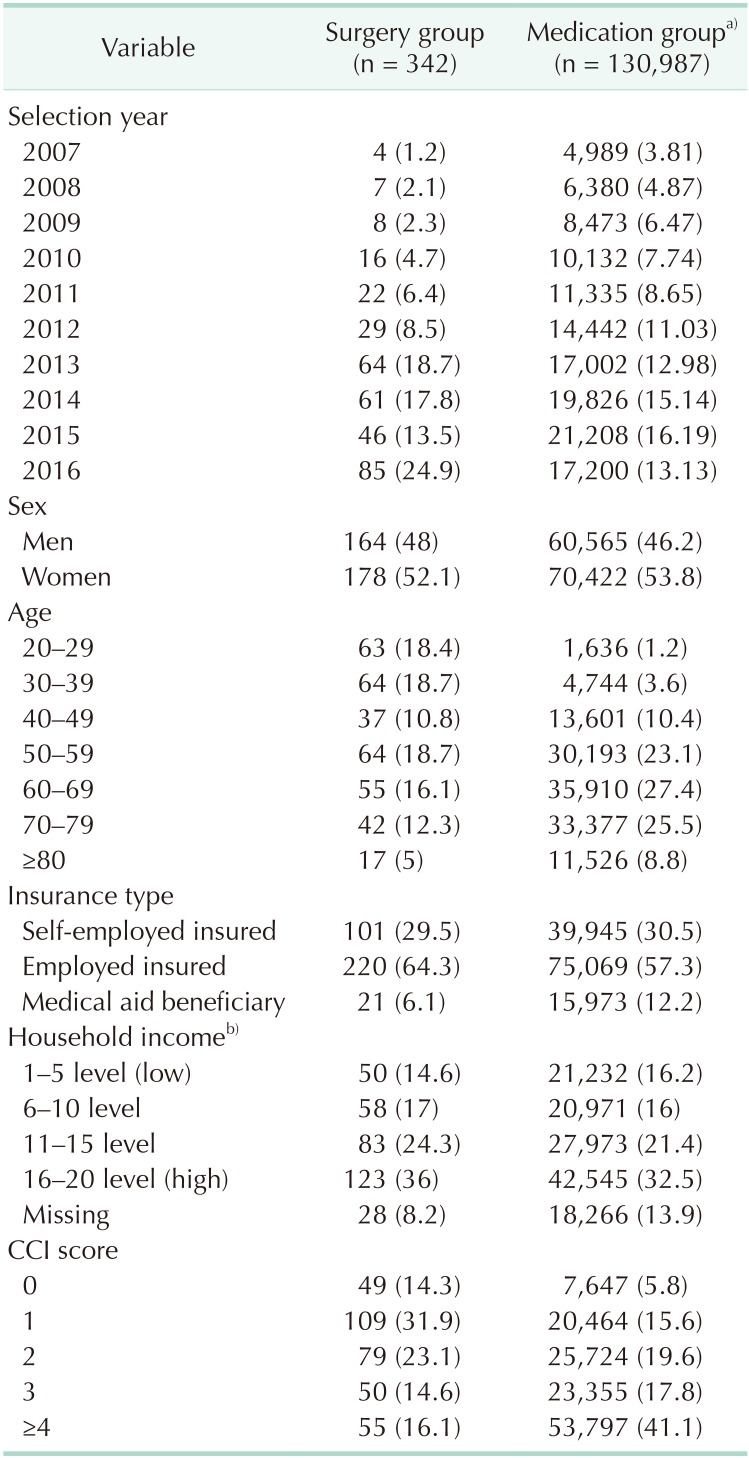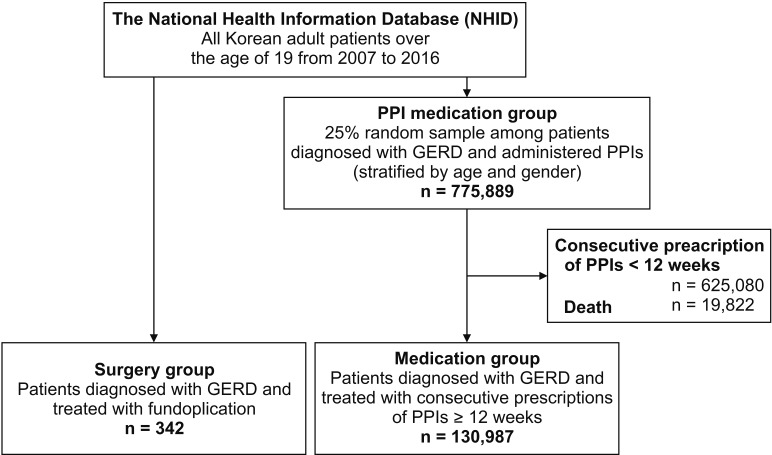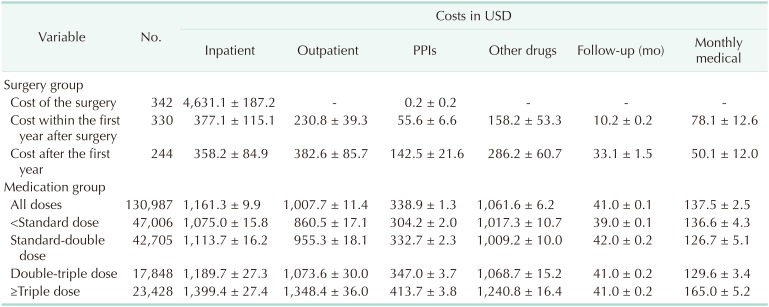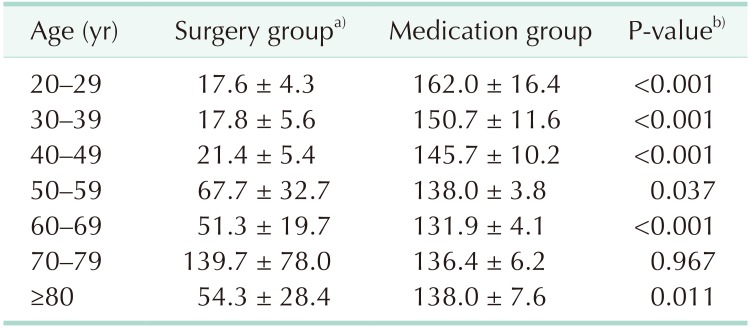1. Nissen R. A simple operation for control of ref lux esophagitis. Schweiz Med Wochenschr. 1956; 86:590–592. PMID:
13337262.
2. Dallemagne B, Weerts JM, Jehaes C, Markiewicz S, Lombard R. Laparoscopic Nissen fundoplication: preliminary report. Surg Laparosc Endosc. 1991; 1:138–143. PMID:
1669393.
3. Bojke L, Hornby E, Sculpher M. REFLUX Trial Team. A comparison of the cost effectiveness of pharmacotherapy or surgery (laparoscopic fundoplication) in the treatment of GORD. Pharmacoeconomics. 2007; 25:829–841. PMID:
17887805.

4. Epstein D, Bojke L, Sculpher MJ. REFLUX Trial Group. Laparoscopic fundoplication compared with medical management for gastro-oesophageal reflux disease: cost effectiveness study. BMJ. 2009; 339:b2576. PMID:
19654097.

5. Funk LM, Zhang JY, Drosdeck JM, Melvin WS, Walker JP, Perry KA. Long-term cost-effectiveness of medical, endoscopic and surgical management of gastroesophageal reflux disease. Surgery. 2015; 157:126–136. PMID:
25262216.

6. Kim JJ, Jang EJ, Kim DH, Park H, Sohn HS. Proton pump inhibitors' use in Korea based on the National Health Insurance Sample Cohort Database (2002-2013). Yakhak Hoeji. 2018; 62:171–178.

7. Kim KM, Cho YK, Bae SJ, Kim DS, Shim KN, Kim JH, et al. Prevalence of gastroesophageal reflux disease in Korea and associated health-care utilization: a national population-based study. J Gastroenterol Hepatol. 2012; 27:741–745. PMID:
21916988.

8. Rubenstein JH, Chen JW. Epidemiology of gastroesophageal ref lux disease. Gastroenterol Clin North Am. 2014; 43:1–14. PMID:
24503355.
9. Galmiche JP, Hatlebakk J, Attwood S, Ell C, Fiocca R, Eklund S, et al. Laparoscopic antiref lux surgery vs esomeprazole t reatment for chronic GERD: the LOTUS randomized clinical trial. JAMA. 2011; 305:1969–1977. PMID:
21586712.

10. Anvari M, Allen C, Marshall J, Armstrong D, Goeree R, Ungar W, et al. A randomized controlled trial of laparoscopic Nissen fundoplication versus proton pump inhibitors for the treatment of patients with chronic gastroesophageal reflux disease (GERD): 3-year outcomes. Surg Endosc. 2011; 25:2547–2554. PMID:
21512887.

11. Grant AM, Cotton SC, Boachie C, Ramsay CR, Krukowski ZH, Heading RC, et al. Minimal access surgery compared with medical management for gastro-oesophageal reflux disease: five year follow-up of a randomised controlled trial (REFLUX). BMJ. 2013; 346:f1908. PMID:
23599318.

12. Lee JH, Park JM, Han SU, Kim JJ, Song KY, Ryu SW, et al. Antireflux surgery in Korea: a nationwide study from 2011 to 2014. Gut Liver. 2016; 10:726–730. PMID:
27114420.

13. Park JM, Chi KC. Antireflux surgery is equally beneficial in nonerosive and erosive gastroesophageal reflux disease. Ann Surg Treat Res. 2018; 95:94–99. PMID:
30079326.

14. Park S, Park JM, Kim JJ, Lee IS, Han SU, Seo KW, et al. Multicenter prospective study of laparoscopic nissen fundoplication for gastroesophageal reflux disease in Korea. J Neurogastroenterol Motil. 2019; 25:394–402. PMID:
31327221.

15. Park S, Kwon JW, Park JM, Park S, Seo KW. Treatment pattern and economic burden of refractory GERD patients in South Korea. J Neurogastroenterol Motil. 2020; 26:281–288. PMID:
31682754.
16. Quan H, Sundararajan V, Halfon P, Fong A, Burnand B, Luthi JC, et al. Coding algorithms for defining comorbidities in ICD-9-CM and ICD-10 administrative data. Med Care. 2005; 43:1130–1139. PMID:
16224307.

19. Arguedas MR, Heudebert GR, Klapow JC, Centor RM, Eloubeidi MA, Wilcox CM, et al. Re-examination of the cost-effectiveness of surgical versus medical therapy in patients with gastroesophageal reflux disease: the value of long-term data collection. Am J Gastroenterol. 2004; 99:1023–1028. PMID:
15180720.

20. Faria R, Bojke L, Epstein D, Corbacho B, Sculpher M. REFLUX Trial Group. Cost-effectiveness of laparoscopic fundoplication versus continued medical management for the treatment of gastro-oesophageal reflux disease based on long-term follow-up of the REFLUX trial. Br J Surg. 2013; 100:1205–1213. PMID:
23775366.

21. Cookson R, Flood C, Koo B, Mahon D, Rhodes M. Short-term cost effectiveness and long-term cost analysis comparing laparoscopic Nissen fundoplication with proton-pump inhibitor maintenance for gastro-oesophageal reflux disease. Br J Surg. 2005; 92:700–706. PMID:
15852426.

22. Mehta S, Bennett J, Mahon D, Rhodes M. Prospective trial of laparoscopic nissen fundoplication versus proton pump inhibitor therapy for gastroesophageal reflux disease: seven-year follow-up. J Gastrointest Surg. 2006; 10:1312–1316. PMID:
17114017.

23. Fock KM, Talley N, Goh KL, Sugano K, Katelaris P, Holtmann G, et al. Asia-Pacific consensus on the management of gastro-oesophageal reflux disease: an update focusing on refractory reflux disease and Barrett's oesophagus. Gut. 2016; 65:1402–1415. PMID:
27261337.

24. Sifrim D, Zerbib F. Diagnosis and management of patients with reflux symptoms refractory to proton pump inhibitors. Gut. 2012; 61:1340–1354. PMID:
22684483.

25. Stefanidis D, Hope WW, Kohn GP, Reardon PR, Richardson WS, Fanelli RD. SAGES Guidelines Committee. Guidelines for surgical treatment of gastroesophageal reflux disease. Surg Endosc. 2010; 24:2647–2669. PMID:
20725747.

26. Katz PO, Gerson LB, Vela MF. Guidelines for the diagnosis and management of gastroesophageal reflux disease. Am J Gastroenterol. 2013; 108:308–328. PMID:
23419381.

27. Fei L, Rossetti G, Moccia F, Marra T, Guadagno P, Docimo L, et al. Is the advanced age a contraindication to GERD laparoscopic surgery? Results of a long term follow-up. BMC Surg. 2013; 13 Suppl 2:S13. PMID:
24267613.

28. Kinoshita Y, Ishimura N, Ishihara S. Advantages and disadvantages of long-term proton pump inhibitor use. J Neurogastroenterol Motil. 2018; 24:182–196. PMID:
29605975.

29. Fibbe C, Layer P, Keller J, Strate U, Emmermann A, Zornig C. Esophageal motility in reflux disease before and after fundoplication: a prospective, randomized, clinical, and manometric study. Gastroenterology. 2001; 121:5–14. PMID:
11438489.

30. Maret-Ouda J, Wahlin K, El-Serag HB, Lagergren J. Association between laparoscopic antireflux surgery and recurrence of gastroesophageal reflux. JAMA. 2017; 318:939–946. PMID:
28898377.





 PDF
PDF Citation
Citation Print
Print








 XML Download
XML Download